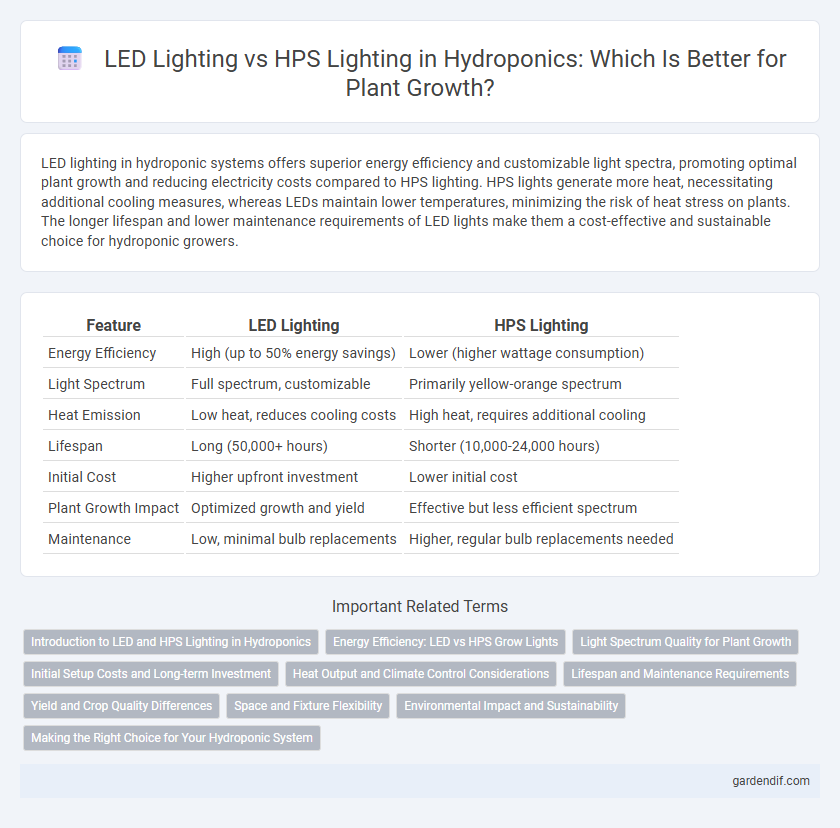
LED lighting vs HPS lighting Illustration
LED lighting in hydroponic systems offers superior energy efficiency and customizable light spectra, promoting optimal plant growth and reducing electricity costs compared to HPS lighting. HPS lights generate more heat, necessitating additional cooling measures, whereas LEDs maintain lower temperatures, minimizing the risk of heat stress on plants. The longer lifespan and lower maintenance requirements of LED lights make them a cost-effective and sustainable choice for hydroponic growers.
Table of Comparison
| Feature | LED Lighting | HPS Lighting |
|---|---|---|
| Energy Efficiency | High (up to 50% energy savings) | Lower (higher wattage consumption) |
| Light Spectrum | Full spectrum, customizable | Primarily yellow-orange spectrum |
| Heat Emission | Low heat, reduces cooling costs | High heat, requires additional cooling |
| Lifespan | Long (50,000+ hours) | Shorter (10,000-24,000 hours) |
| Initial Cost | Higher upfront investment | Lower initial cost |
| Plant Growth Impact | Optimized growth and yield | Effective but less efficient spectrum |
| Maintenance | Low, minimal bulb replacements | Higher, regular bulb replacements needed |
Introduction to LED and HPS Lighting in Hydroponics
LED lighting in hydroponics offers energy-efficient, customizable light spectra that promote faster plant growth and higher yields compared to traditional HPS lighting. High-Pressure Sodium (HPS) lamps emit a broad spectrum with strong yellow and red wavelengths, commonly used for flowering stages but generate more heat and consume more electricity. Utilizing LED technology in hydroponic systems reduces heat stress on plants and lowers operational costs, enhancing overall crop quality and sustainability.
Energy Efficiency: LED vs HPS Grow Lights
LED grow lights consume 40-60% less energy compared to traditional HPS lights, translating into significant cost savings for hydroponic growers. LEDs convert a higher percentage of electricity into usable light wavelengths, boosting photosynthetic efficiency and crop yield. HPS lighting generates more heat, requiring additional cooling systems that further increase overall energy consumption.
Light Spectrum Quality for Plant Growth
LED lighting offers a precise light spectrum tailored to photosynthesis, boosting plant growth and nutrient absorption compared to traditional HPS lighting, which emits a broader, less efficient spectrum with excess heat and energy waste. The specific wavelengths provided by LEDs enhance chlorophyll production and photomorphogenesis, leading to improved crop yield and quality in hydroponic systems. In contrast, HPS lights primarily emit yellow-red wavelengths, which can limit vegetative growth and spectrum efficiency for different plant stages.
Initial Setup Costs and Long-term Investment
LED lighting for hydroponic systems involves higher initial setup costs due to advanced technology and energy-efficient components, while HPS lighting offers a lower upfront price but consumes more electricity over time. Over the long-term, LED lights deliver significant savings by reducing energy consumption and maintenance costs compared to traditional HPS bulbs. Investing in LED lighting enhances sustainability and lowers operational expenses, making it a cost-effective option for intensive hydroponic cultivation.
Heat Output and Climate Control Considerations
LED lighting generates significantly less heat compared to HPS lighting, reducing the risk of heat stress on hydroponic plants and minimizing cooling requirements. The lower heat output of LEDs facilitates easier climate control, enabling growers to maintain optimal temperature levels without extensive ventilation or air conditioning systems. This energy-efficient characteristic of LED lights contributes to a stable growing environment and reduced operational costs in hydroponic setups.
Lifespan and Maintenance Requirements
LED lighting for hydroponic systems offers significantly longer lifespan, typically ranging from 50,000 to 100,000 hours, compared to High-Pressure Sodium (HPS) lighting which lasts around 10,000 to 24,000 hours. Maintenance requirements for LED lights are minimal due to their durable design and low heat output, reducing the need for frequent replacements and cooling system upkeep. HPS lighting demands regular bulb replacements and higher maintenance efforts because of heat generation and shorter operational life.
Yield and Crop Quality Differences
LED lighting in hydroponic systems enhances yield by providing targeted light spectra that promote more efficient photosynthesis and healthier plant growth compared to HPS lights. Crop quality improves under LED lights through better control of light intensity and spectrum, resulting in higher nutrient density and more vibrant coloration. HPS lighting tends to generate more heat, which can stress plants and lower quality, whereas LED systems deliver consistent illumination with reduced thermal impact, optimizing both yield and crop quality.
Space and Fixture Flexibility
LED lighting offers superior space efficiency compared to HPS lighting, as LED fixtures are compact and can be arranged in various configurations to maximize vertical and horizontal growing areas. The flexible design of LED fixtures allows growers to customize lighting setups, fitting into tight or irregular spaces commonly found in hydroponic systems. HPS lights, being bulkier and heavier, limit fixture placement and often require larger clearances, reducing usable growing space.
Environmental Impact and Sustainability
LED lighting in hydroponic systems significantly reduces energy consumption compared to HPS lighting, lowering carbon emissions and operational costs. LEDs emit less heat, decreasing the need for additional cooling and further conserving energy resources. The longer lifespan and recyclable components of LED fixtures contribute to sustainable practices, minimizing electronic waste in indoor agriculture.
Making the Right Choice for Your Hydroponic System
LED lighting offers higher energy efficiency and customizable light spectra, promoting optimal plant growth in hydroponic systems compared to traditional HPS lighting. HPS lights provide intense, broad-spectrum illumination beneficial for flowering stages but generate more heat and consume more electricity. Selecting the right lighting depends on balancing cost, energy consumption, plant growth stages, and environmental control within the hydroponic setup.
LED lighting vs HPS lighting Infographic

 gardendif.com
gardendif.com